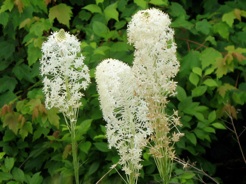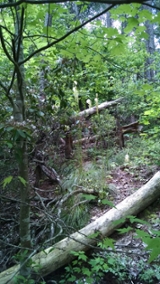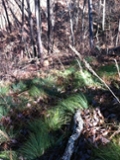Committee:
Jonathan Stober (Chair): Wildlife Biologist, Shoal Creek RDRon Determann: Atlanta Botanical Gardens
Ryan Shurette: U.S. Forest Service
Contact point: Jonathan Stober (Chair): jstober@fs.fed.us 256-463-2272x107 Shoal Creek RD Talladega National Forest, U.S. Forest Service
Project Rational: Xerophyllum asphodeloides (L.) Nutt. (Eastern Turkeybeard) is a perennial forb in the Liliaceae family. It occurs in the lower 48 states from Delaware to AL (AL, DE, GA, KY, MD, NC, NJ, SC, TN, VA, WV). It is “rare” in GA, “historical” in KY and DE, and “threatened” in TN. Prior to 2014 there were only 2 known sites in Alabama on the Shoal Creek Ranger District of the Talladega National Forest. Eight additional sites were found by Jonathan Stober during the winter of 2014, along the Cleburne and Calhoun County border. A population survey was conducted at all known sites in December of 2016 by Robert Carter at JSU with clusters numbering from 23 to over 290 plant clusters with 3 populations over 200 plants and the remaining populations ranging between 23 and 101 clusters with a total of 1100 plant clusters identified.
The Alabama Heritage Program ranks it G4, S1. It blooms in full sun in May or June on dry rocky northwest facing ridges. It has a showy raceme of perfect white flowers standing 3 feet above a tuft of grasslike leaves. This is the most western known population and the only know population in Alabama. The basal foliage resembles a young longleaf pine tree. The longleaf pines of these Appalachian ridges and the turkeybeard both respond to regular burning. The US Forest Service has burned the turkeybeard sites and plans to continue to burn these ridges above Shoal Creek regularly. Thus the Alabama turkeybeard site is protected by ownership (USFS) and managed with prescribed fire.
Short-term Goals:
- Establish population baseline (2016)
- Collect seed annually across populations (2014-present)
- Pursue information on the soil and geology of sites (2017-2018)
- Pursue genetic analysis of populations (2017-2018)
- Document techniques for germinating and propagating seedlings (2016-2018)
- Examine prescribed fires influence on populations (2017-2018)
Long-term Goals:
- Established agreements and funding for propagating ABG (2016)
- Funding available (2020)
- Identify sites for restoration and continue search for additional populations (2019-2020)
- Begin outplanting and propagating new populations (2021)
Accomplishments:
- Established population base line and have gone from less than a 100 known plants in 2 populations in 2009 to over 1100 plants in 10 populations in 2016.
- Established germination and propagation techniques; need to further document.
- Established fund source for future propagation.





